Inseparable 398
12
12
|
|
Brian sent me a link to the Inseparable 398 - a pocket cruiser limited to 3.98m to avoid the Italian 4m rules.
She is very similar to MilliBee (4.26m or 14ft) with a max beam of 2m or 1.55 beam at the waterline. 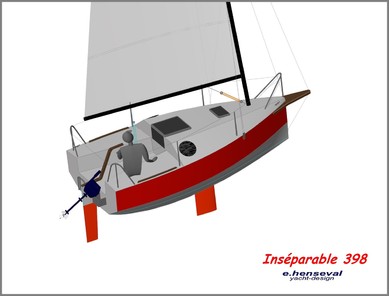 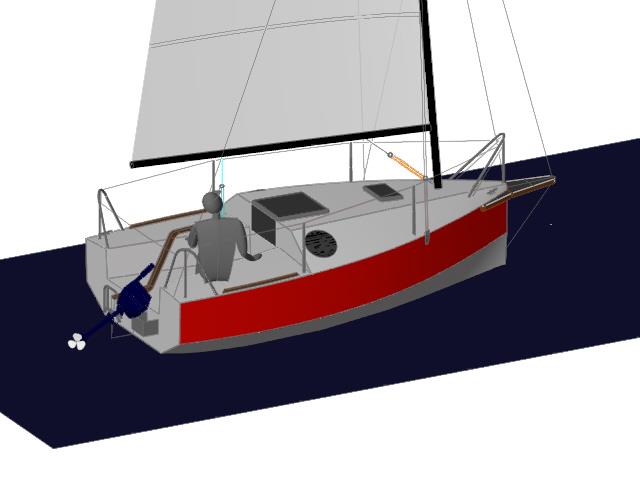 http://hensevalyd-english.jimdo.com/monohulls/inseparable-398/ Clearly the designer has an excellent taste in colours! I quite like the cat boat rig (stayed mast) which saves all that faffing about with a jib which 1) doesn't add much power 2) adds a lot of things to go wrong 3) make single handed sailing harder 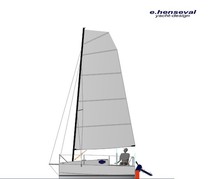 The high aspect ratio sail with a twist area at the top is almost identical to the good quality, efficient, fully battened and stable windsurf rigs we used in the 80s. Construction pics are here: https://www.facebook.com/pages/Ins%C3%A9parable-398/539816812725908 With MilliBee's recent modifications, it's easy to add a support post (down to the hog) for stepping on the extended foredeck with plenty of fore/aft tuning adjustment. Seems like it would be a good experiment for MilliBee's as yet undecided new rig, yes? -Paul |
|
|
I sent Eric an email about creating an illustration in green and cream and tan sail, but he misunderstood my request, and confirmed I could paint her any colour I wished.
He did however ask the following "I permit myself to ask you if you could give your opinion on which specifications would be the best to answer the main demand in this category of boat. However, Inseparable has been designed for one person, with very accurate specifications! I am working too on a simple furling free standing mast, without boom, for a friend, but all rigs are possible!" So, what might be improved to fiction even better. These micro yachts are rather specialised but Paul has certainly had a lot of fun with his over the years. Brian |
|
|
An Inseparable with a Brol rig ??
Thats a very interesting new, Brian !! do you have more informations ? (we are following this adventure from the very begining on Nautical Trek http://www.nauticaltrek.com/12789-inseparable-398-henseval-yacht-design & http://www.nauticaltrek.com/12827-la-construction-de-rannvo-breizh, and mast furling sails on http://www.nauticaltrek.com/12771-2-voiles-ferlables-sur-mats-non-haubanes-montaubin-hobie-raptor-etc) Eric17 (not Henseval) |
|
|
I asked E. Hensval for more information about the new rig, and the answer was :
[quote] Quant au free standing rigging, je n'ai pas commencé. [/quote] 
|
|
|
here are three illustrations of Inseperable finished in traditional colours.
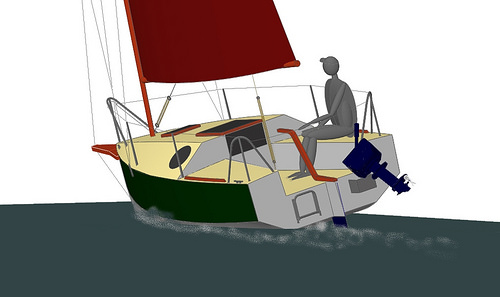 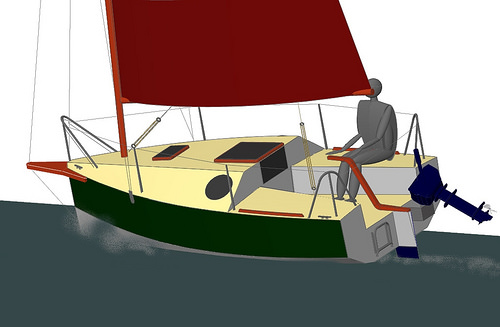 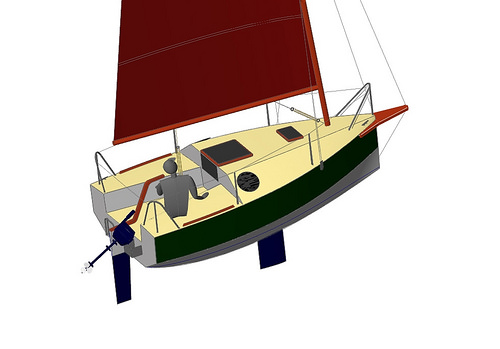 Brian |
|
|
I must admit that, at first glance I was very interested in this design. A seaworthy trailer-sailor in a very small package.
I don't subscribe to the belief that small is always better and the smaller the better, but something which I can build and store in my 16ft garage is always worth a second look. The thing that first put me off about this design is the drop keel/daggerboard. I haven't read through all the spec. but it weighs in at 112kg. and slides up and down vertically. 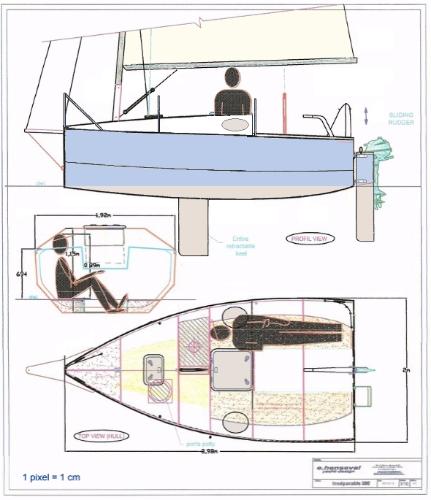 No doubt all the weight is needed to keep the rig upright, and the keel won't be a problem when in deep water but it does seem to encroach into the cabin space quite significantly. This is no doubt why the designer has placed the sleeping arrangement in a quarter berth under the cockpit seats. Now I'm quite supple but it would be a bit of a wriggle to get in and out of there every time nature calls. There would be plenty of room to have a swing keel under the raised cockpit floor, giving much more space in the cabin, but then nowhere to put your legs when sitting having a cuppa. Our club owns a Sailfish and we're begining to understand the drawbacks of a vertical dagger board which doesn't kick up when it hits bottom and needs 99 turns of a handle to lift it. This is probably a great boat for those who normally sail in deep water and are prepared to sacrifice any comfort for performance, but not this old git who wants to spend more time sitting on the beach drinking tea. |
|
|
This post was updated on .
Eric Henseval mentioned to me that he designed this boat to a very clear single person spec. The owner knew exactly what he wanted and in many respects lots of good decisions have been made, however Eric did ask if people wanted to develop the design for more general use he would welcome feedback and new ideas. So please let him know your thoughts which he would be happy to receive.
I had a Swift 18 moored at Keyhaven, with a screw winch which took ages to wind up. The problem owners had was that the profiled keel meant there was a gap on both sides between keel and centre case and mud and stones were forced up in the gaps and jammed the case. A number were lifted and raised high in the air on the crane to clear the case. I was glad Inseperable was not fitted with a bulb, which would have prevented happily sitting on the beach or mud. It's good the keel does lift up right out of the way. As for lifting her the Laser Stratos Keel had a 100 kg bulb, about the same weight, and that lifted easily with a block and tackle on a folding tripod or in this case a block fixed to the roof. Guess the space inside might be too small for us more mature sailors. With the rig so far forward and no jib, the keel will need to be forward as well. Perhaps a lug yawl rig might allow the keel to be under the cockpit? You end up viewing twin keels as the least worst option for drying berths. Simple, robust and reliable. Some French yachts have modern properly profiles twin keels. Our twin keel Moody 27 worked great for Keyhaven and she sailed really well, more two well profiled keels than older plate keels. Draft would still be minimal and much more room inside. Perhaps Eric might draw such a version? Brian |
|
|
This post was updated on .
the main specification was the boat should be less than 3,99 m, as these boats don't pay taxes in Italy !
But Aurelio is 1.80 m tall, and needs minimal accomodations. The other requirement was, indeed, "no bulb", to have a flat bottom with lifted keel (and be lying very low on the trailer), just like the "CartOOn 400" (http://www.nauticaltrek.com/12763-le) and unlike the Krill 2 (http://www.nauticaltrek.com/11573). Eric (not Henseval, again !) PS : ...drinking only tea, Graham ?? 
|
|
|
RM Yachts of France produce modern twin keel yachts built of plywood.
http://www.rm-yachts.com/contenu/,rm_1260,43?chglg=en 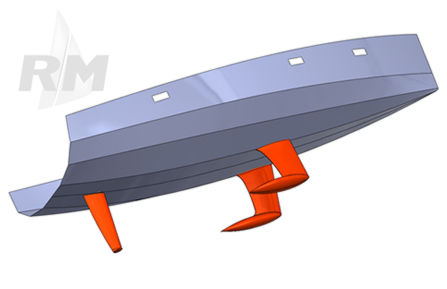 There is another important consideration when small yachts are kept on a half tide mooring. When the keel is lifted, dagger or centre board, it means the centre of gravity is raised and these boats have a tendancy to "sail around" their mooring when the wide blows hard and tides are moving. This is not an inconsequential issue. Quite a few boats have flipped on their mooring at Keyhaven. Including a Swift many years ago, other craft and even a quite large Parker 235 last winter. Brian |
|
|
This post was updated on .
In reply to this post by Port-Na-Storm
I agree with Graham, 80% of the birth is under the cockpit which will be a squeeze.
Also with the cockpit seats so high there is no protection for the skipper from the weather, which is going to hit you at full speed all the way from the Atlantic with nothing in the way, ouch. I prefer the early mock-up version they did. The skipper sits a little lower with more protection from breaking waves, and there is space to walk around the cabin to the mast (possibly too wide). In the final version you have to exit the cabin vertically, so driving rain will get inside the cabin. The traditional sliding roof/companionway keeps a cabin remarkably dry. 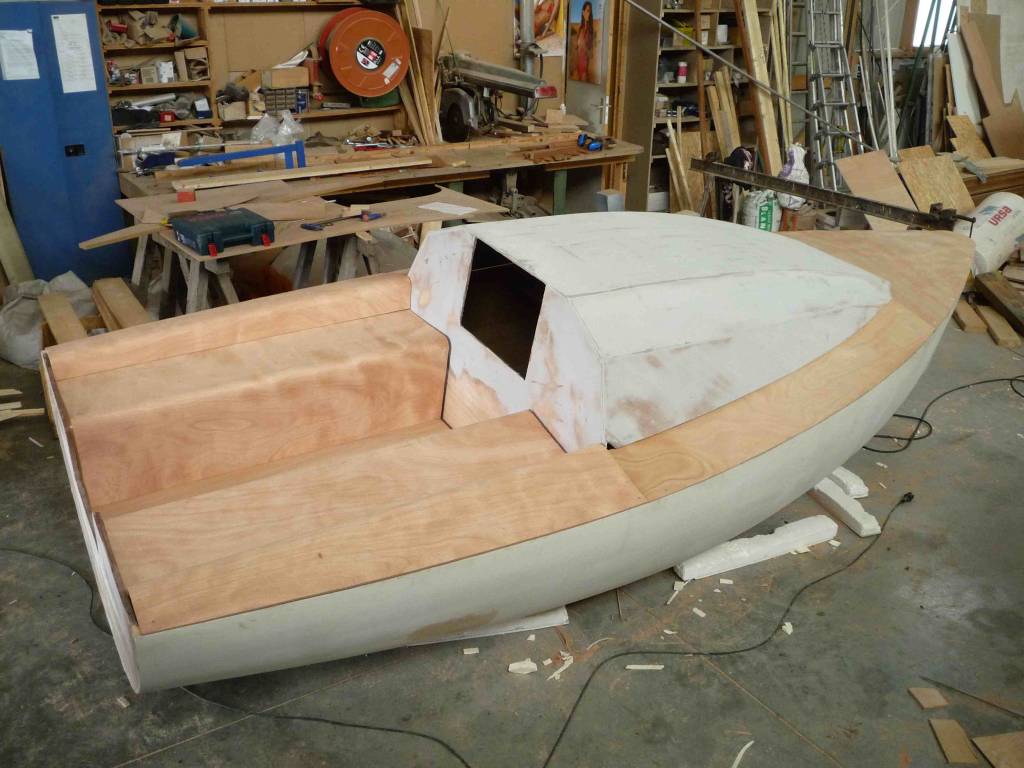 Also I'd fill in the transom so that boots, rigging, cups of tea and small children are not lost out the back in the blink of an eye. And imagine the joy of a following sea washing into the cockpit every few seconds. When trailering the cockpit is great storage for: rudder, outboard, paddles etc. but only if you have a substantial transom to keep the contents secure. -Paul |
|
|
Great place to watch the world go by
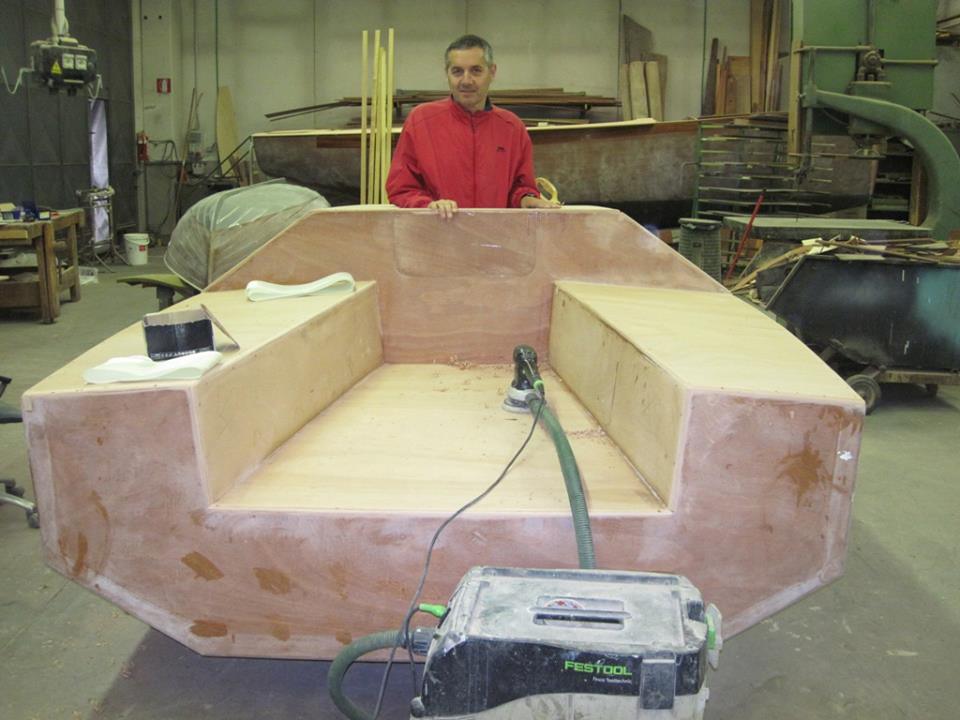 Just see the top of the case bottom left, not full height. 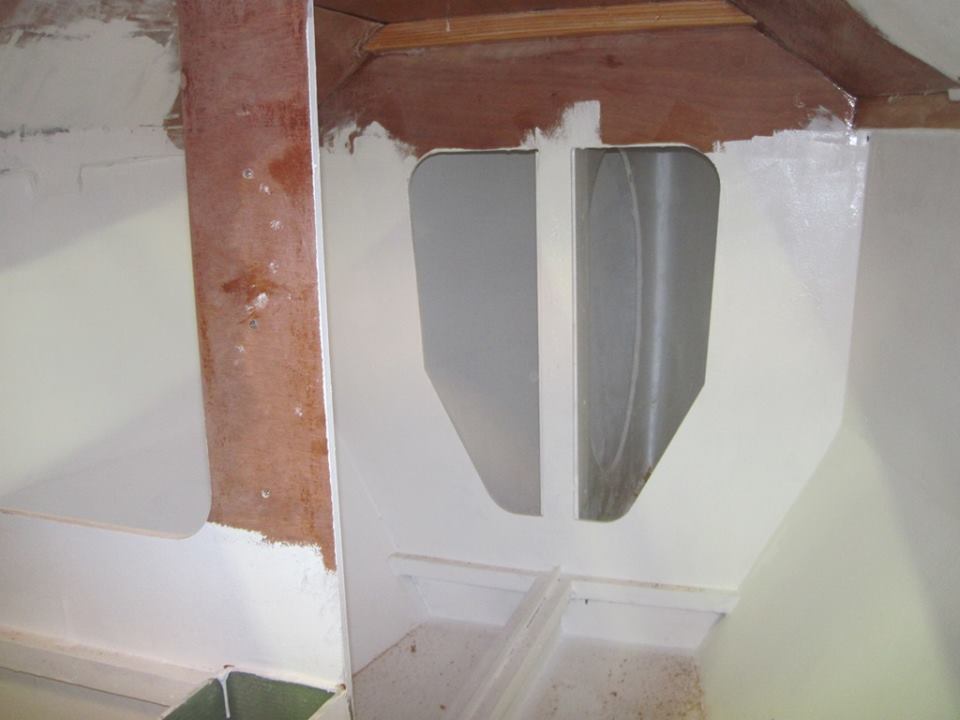 Quarter berth 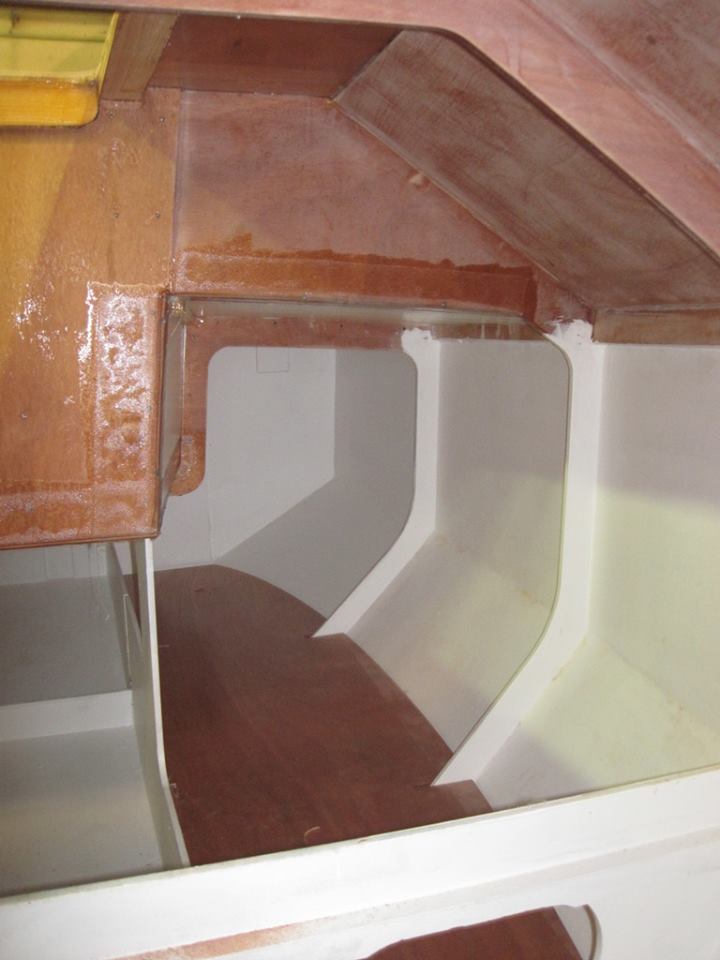 Skipper in berth  Sitting upright on berth, seems to have clearance for head 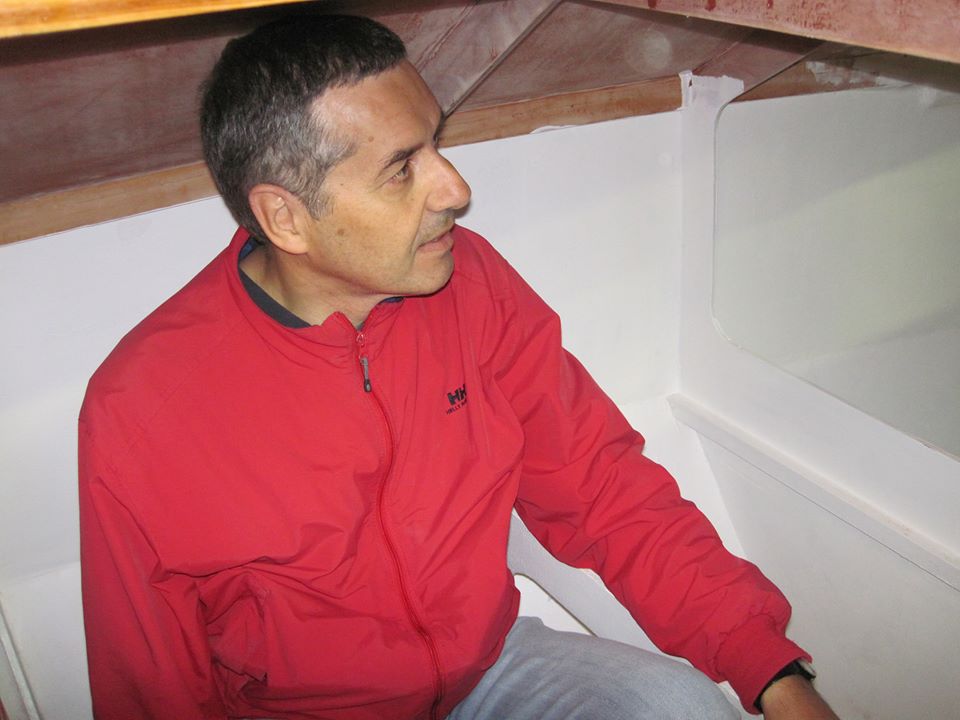 Paul, I once sat back on the saloon seat of a Gratside 20' gaffer and my head hit the dog house sides well before my back reached the seat back. Incredibly uncomfortable, quite surprised that the ergonomics could be so bad from a leading designer. Do your wide side decks allow you to sit back ok? Brian |
|
|
In reply to this post by Paul H (admin)
Paul, the boat with protected seats (and curved plywood) is a "Krill 2", design Auzepy-Brenner, build in strip planking by Delamare boatyard in Honfleur.
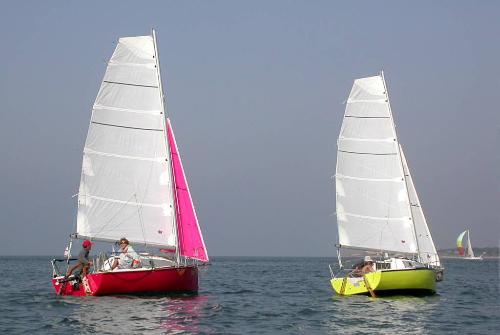 (was on the NT page just for comparison) |
|
|
It is interesting that so many design faults are ignored by professional designers....
Why? First a quick point - if you want a cockpit that is open aft on the (questionably arrogant) assumption that you are going to outrun any following seas, then rig a net to catch stray cups, shoes, children, etcetera. Like Paulie says - have yourself a ball sitting out there for hours on end in an Atlantic storm, clutching the tiller. 'Tit Willow' is exactly the opposite, including lovely, tall, back-restful cockpit coamings on the alternative scenario that Willy the White-top is going to have to try really hard to climb aboard: 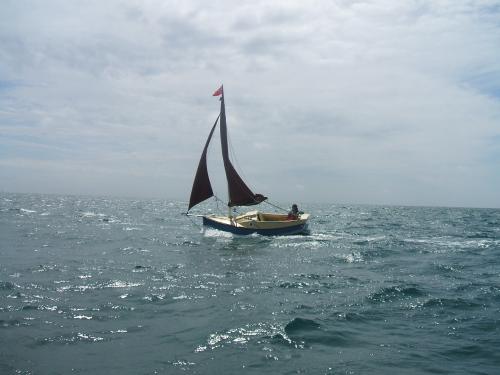 Anything that does make it, if it doesn't fall out in the next plunging roll, has permission to drain out through six small scupper type holes, the self-draining foot-well, or the tiller aperture which is not a bad size and possibly even the rowlock ports in extremis. That incidentally is why the foot-well is so small: 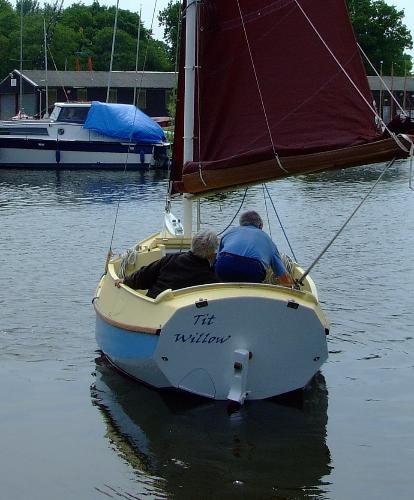  Then down below again. 'TW' is small (15.5 feet) - really only enough for one, but below she allows a really comfy slouch, sufficiently upright to drink scalding coffee, or precious gin; this compares idyllically with the Roxanne - over twice her length. I went aboard one moored next door to her once and it suffers from that same dilemma; you can sit upright on the edge of the settee bunk with your head in the cabin space, but there is no way I could slump back without actually tucking my head under my arm. What a beautiful waste of thirty odd feet. And onto my next hobby horse; the discussion above is festooned with the desire for something seaworthy that has a retractable keel to take the ground.... Come along possums, I'm going to be terminally arrogant and you've all seen these photographs many, many times before, but here's one I made earlier:  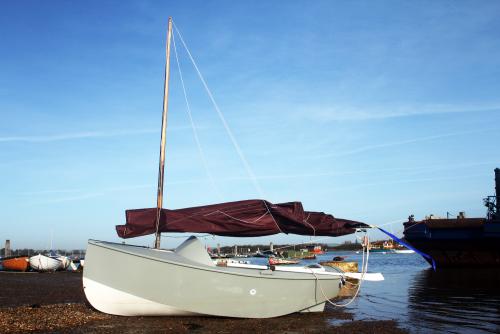 OK, this one is very small and for other reasons seriously narrow, but as stated before, this is a basic notion - yes a "Premise" that you can apply to any reasonable length you desire and make it as beamy as you want. Similarly, with water ballast, even this tiny one is self righting, admittedly somewhat reluctantly once swamped: http://www.youtube.com/watch?v=JxIZSSj8QlM A standing headroom cabin is possible at twenty-four feet; with permanent ballast: 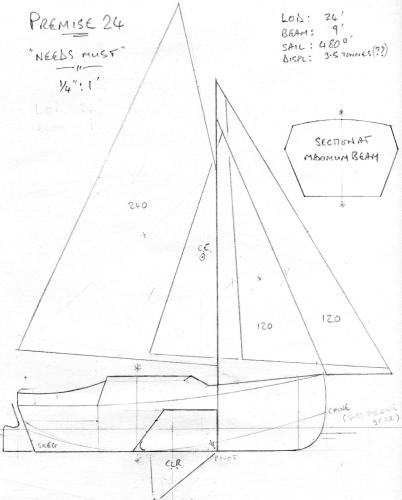 And actually, if my mind had wandered this far before I built 'Tit Willow', she would never have existed; I would have produced a water-ballasted Premise Sixteen (15.5ft LOA, 5ft beam, with as single 100sq. ft. unstayed balance lug, though you name the rig and I'll play along). Here is my ubiquitous cardboard cut out: 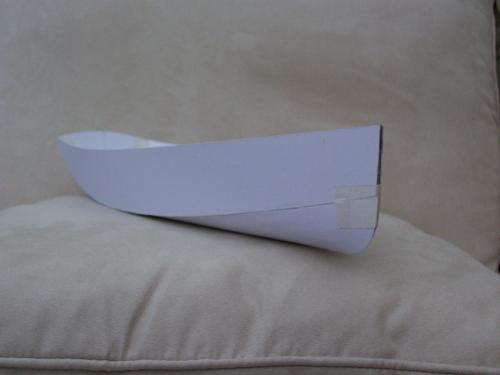 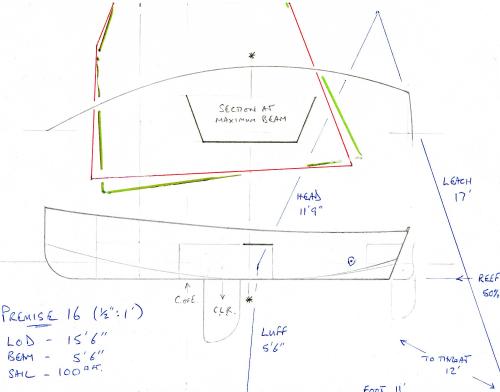 With hindsight I would have adorned her with a sit-able snug cuddy/cabin somewhere between that of diminutive 'Polly Wee' and 'TW', or the Welsford Scamp and to minimize intrusion by the centreboard case, probably made the board triangular, the same as it is in TW and the Premise 24 above. I'm not going to build this one - not for myself, I already have a beautifully seaworthy sixteen foot gaffer and a cute little twelve foot raider; though if you ask nicely, one day.... Is the Premise that ugly that only her designer could love her? To save on tears, Maybe you shouldn't answer that CW |
|
|
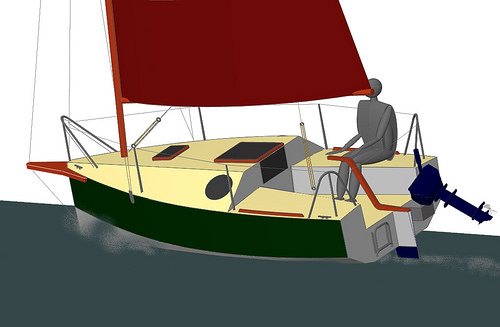 Here's a defence of that stern, and what do I see when I look at it. More people drown climbing from the tender than any other way when sailing. I see easy safe climbing aboard using the ladder fixed to the stern. No height to climb from what would probably be a tiny inflatable. Climbing down from the boat when leaving her, would equally be easy and safe. Similarly, not big up and over lifts with the outboard, either from the tender or down over the transom, the worst possible lifting for anyone with a back issue. It would be a low lift from the tender or a low drop on your knees to the bracket from the cockpit. Wonderful. I love sea swimming, from early in the season to late autumn. If I am to swim from a boat at anchor I need a safe and easy way of getting into the water and more importantly back out. That ladder on the open stern is exactly what I need. A fixed in place method or re-boarding a boat from the water seems like an essential safety feature to me. Should I worry about that open transom when sailing. All I can use is my experience to judge. I spent quite a few seasons race crewing on a wonderful small yacht, a 22' Sprinta Sport. Terrific boat, so well behaved under far too much press of sail. We would often be the only yacht still flying a spinnaker in the strongest winds. She has a very low open transom, and I never once saw water coming aboard from the stern. We raced in far stronger winds than this little cruiser would ever sensibly be sailed in. Inseperable has quite a depth between cockpit floor and hull, more than the Sprinta. So, there you go, different eyes, different conclusion. No right, no wrong, just a different view. Brian |
|
|
More than anything, I see a huge difference in style between English and French sailboats. Watch the boats used for the Jester Challenge : in France, for the same event, you would only see racing machines. In each French navigator, there seems to be a Tabarly dormant, and even for quiet cruises, French sailers choose boats that look like racing boats, with all the disadvantages it may present.
The Inseparable is actually a "miniature Pogo", and a smaller version of the Aviateur by same designer. Therein lies the main problem, I think: the Aviateur and Souriceau clearly state blue water ambitions, while the designer makes it clear that the Inseparable is not for that. So why design a boat for only coastal navigation as if he had to face the open sea ? On the one hand it leads to options not necessarily suited to the small cruise, and worse, I 'm afraid it will give some people very bad ideas... For the companionway, the "Hassler mousetrap" is a choice of Aurelio, only for young people, i fear... And for the "Premise", Chris, despite all my efforts I have not convinced many people ... Do you know how "formply" works?? Would be much easier... Eric(17) |
|
|
Brian and Eric, some interesting thoughts
The question of getting on and off a larger boat from and to a smaller one. For a while I found myself accidentally using a Sigma 38 with a reverse counter which included a step. Seems like a good idea and the levels were right, but with the reverse there was not so much to hold onto at the crucial moment. Perhaps more importantly, at anchor or simply without way on, there was frequently enough of a lop that the yacht was pitching sufficiently to trap the rubber dinghy under the counter and make boarding over the stern a real problem. Boarding over the side amidships minimizes the movement of the two craft relative to each other. Having said that, when imagining the ‘Premise 24’, I considered alternative power systems; apart from the sails that is. One of the options was an outboard through a largish hatch in the transom and I saw the possibility for boarding and swimming from this as well…. And talking of hatches in the transom, TW actually has an outboard well in the cockpit; this in turn has space to stow the outboard just ahead of it: 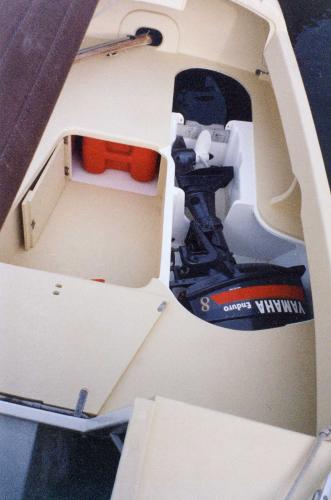 The arrangement worked quite well, which is more than I can say for the outboard(s). The one in the picture did not like being stowed on its side and salty-over-heat-corroded-up to prove it. The second smaller one, despite having more attention paid to it, was eventually found to have an irreplaceably cracked crankshaft; both were taken out the back and shot. Bloody outboards; this pair were two-stroke, the modern ones demand that they are kept upright at all except brief and beautiful moments, in case they should come to a disagreement with their sump oil. How come a Spitfire could fly upside down for as long as it took, but modern OB’s are heavier and much, much prissier than those they replace? These days I have really given up such torment, in favour of the purism of sail and oar. Then as Eric indicates, the obsession, which is not purely a French phenomenon, with designing cruising boats that look like racing boats. Unless you are actually racing, then you are losing the vital cruising elements of both safety and comfort just to pose a bit. Or worse, just because that is what everyone else is doing and they, like sheep, have gone that way. I’ve just looked up ‘Formply’: http://www.plywoodcity.co.nz/shop/Formply.html It occurs to me that if you seriously impregnate flat sheets of ply in epoxy that they will be very resistant to bending. Would it not be better to bend them first? Then impregnate with epoxy, even at normal temperature, so that they are forever aware of what is expected of them. And perchance even sheath them in Tesco’s finest poly-cotton? Mmmm, strong! Which brings me back to the ‘Premise’; yes, it’s a weird one, I cannot deny. It is also unfortunate that the little ‘12’, the first of a genre is, for good reason but to no improvement in her appeal, considerably tall and narrow. She is of course a prototype, fought into the world by eye, not CAD; now the planks are formed, it would be easy to make templates and produce stitch and glue copies with the same ease as a ‘Mirror’ dinghy for instance. Whatever; she does the biz sufficiently to indicate that the principle is sound. And her pedigree comes from the eloped union of a couple of beauties: 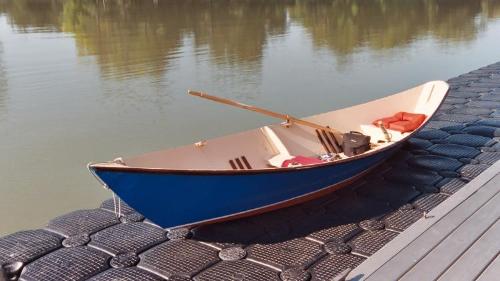 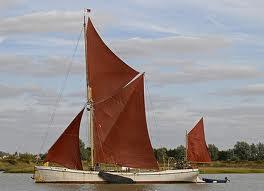 A simple, seaworthy, self-righting, flat-bottom, camping dinghy, with a reasonable turn of speed. I rest my case…. In the stern-sheets when going downwind Or side-decks for windward work But mostly on the thwart CW |
|
|
Chris,
The "Premise" might well be applied to this boat, as on all 5 sided hulls (or more), like on the Winsome or the Trouper 12 by Swallowboats. (Well, for the Trouper, I just suppose, as I've never seen any picture of the forefoot ... but I will not hijack this thread for that!). Eric(17) |
|
|
Ah, Eric!
The philosophy of hull shape. The problem seems to me to be that folk imagine a rounded chine hull, then try and work out how many chines they need to approximate to that, without offending their senses. A flat bottom plank may, or may not, be involved in this process. If it isn’t then there will be an even number of planks, four, six, eight etcetera, divided by a definitive keel structure. If there is a bottom plank, then it must be counted along with those making up the rest of the hull – three, five (your suggestion), seven and upward. If you start by thinking from the opposite direction – simplicity, that is how few planks you can use to produce an acceptable hull, then the question becomes much more interesting. ‘One’ is obviously out as it has no volume, two planks make a ‘V’. This could be one hull of Wharram’s famous catamarans, or it is almost possible to imagine the deep ballasted hull of the English Victorian yachts; I am sure there must be a French equivalent. The next number up is three; the first number to provide genuine volume and stability. This has traditionally and particularly in North America, produced a hull with considerable floors and near vertical sides, even if some of them have a quite marked and admirable shear. The problem remains that with few exceptions, they are not really sea-boats, being designed and built originally by people with little maritime experience, for use in sheltered waters. They are not notably weatherly, or even sea-kindly. This is confirmed by the flat-bottom ‘sharpies’ found round our own inland and protected coastal waters. The ‘Premise’ is an attempt to retain those three-plank, flat bottom, single-chine, ply-friendly, ‘simple’ curves, rather than having to tackle ‘compound’ curves. Meanwhile soothing the ensuing hard edges, to avoid the seagoing limitations of the traditional designs. So the challenge remains, to produce a simpler hull that fulfils these criteria I’m a dither of expectancy…. And it’s your move next Your ‘Sale Anglais’ |
|
|
My dear neighbor,
The ideal answer would have been an "Inseparable" with a rounded forefoot (and hindquarters) ... For the front part, it seems possible. To the aft part, the rocker (typical of Henseval, it is found on all designs) will make the conversion very difficult ... But in fact my current project abandoned the premise (treason!) for rounded sides made in strip planking. It could change with the use of Superform plywood (not formply, as I wrongly wrote earlier) 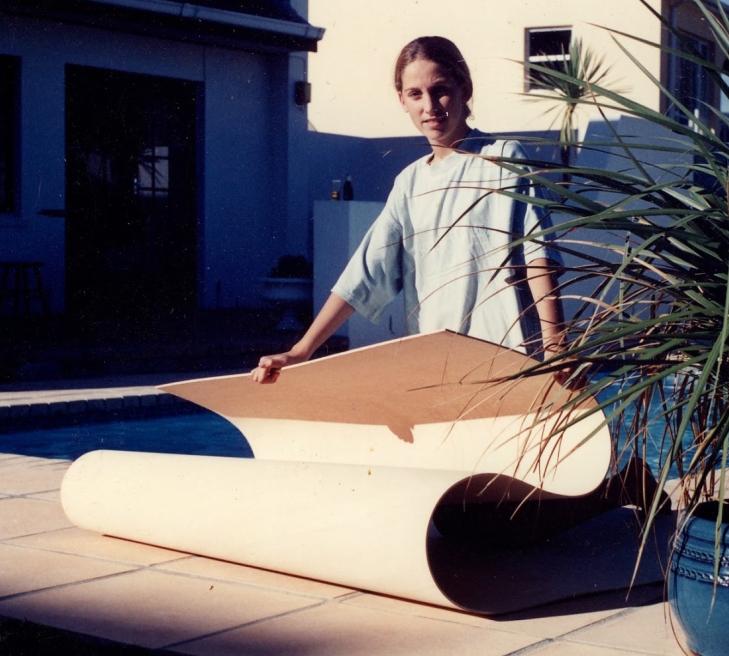 Eric |
|
|
So, if Inseparable can fly two love birds on her sail as an insignia, what does Promise fly on her sail?
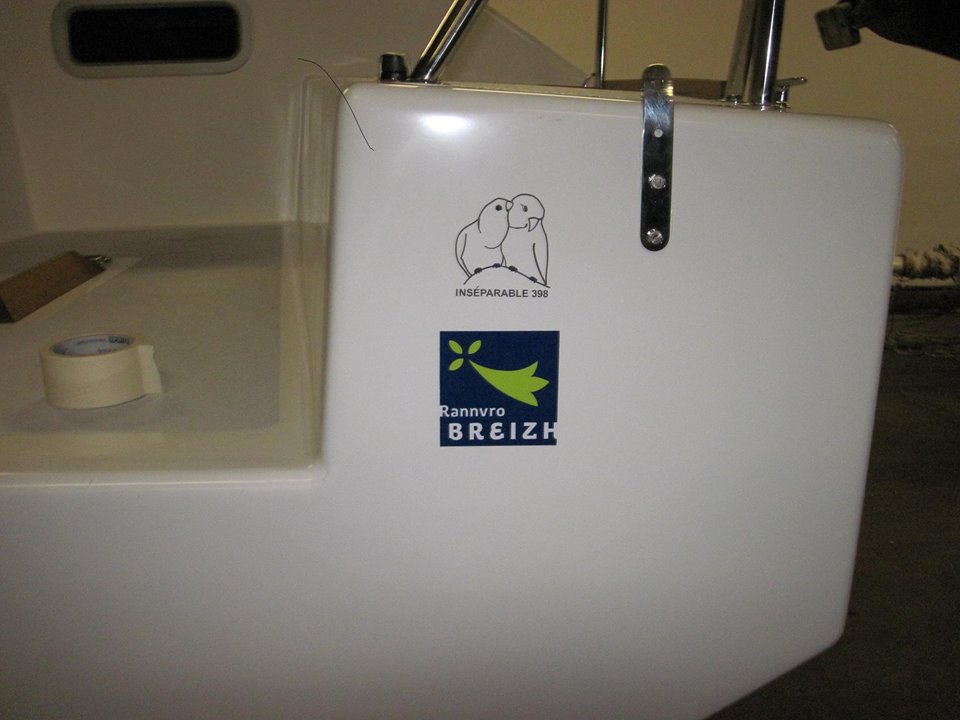 |
«
Return to General Discussion
|
1 view|%1 views
| Free forum by Nabble | Edit this page |

